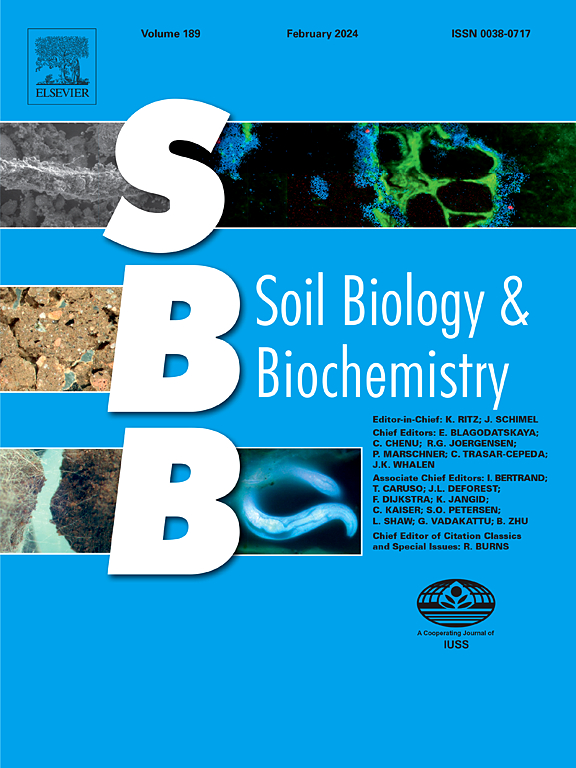A method to isolate soil organic phosphorus from other soil organic matter to determine its carbon isotope ratio
IF 10.3
1区 农林科学
Q1 SOIL SCIENCE
引用次数: 0
Abstract
Despite the importance of soil organic phosphorus (OP) for plant nutrition, its dynamics in soil remain elusive due to the lack of multiple stable P isotopes. Here, we developed a method that isolates the soil OP pool from other soil organic matter to measure its carbon isotope signature to elucidate soil OP decomposition. We tested three extractants (H2SO4, HCl, and NaOH in 0.5 M) for their capacity to preferentially extract OP. For isolating OP from the extract, we evaluated different pH adjustments (pH 1.5–10) and iron- or aluminum hydroxide additions. Finally, we determined the carbon isotope ratio (δ13C) of the isolated OP pool. We found that the H2SO4 extracts had the highest OP content and the lowest organic carbon (OC):OP ratio compared to the HCl and NaOH extracts. The pH adjustments of the H2SO4 extracts to pH 4–7.5 removed ≥93 % of the extracted OP from the solution. The OC:OP ratio of the precipitates was the lowest (11–16) at pH 7.5, showing a strong preferential OP precipitation caused by the pH alteration. Metal hydroxide addition (combined with pH treatment) did not improve the preferential OP removal. The δ13C of the OP reflected differences in the vegetation (C3/C4) that grows at the soil sampling sites. Overall, this method provides a simple and effective approach to isolate the soil OP pool from other soil organic matter and determine its carbon isotope ratio, which opens new avenues to study soil OP dynamics.
一种从其他土壤有机质中分离土壤有机磷并测定其碳同位素比值的方法
尽管土壤有机磷对植物营养具有重要意义,但由于缺乏多种稳定的磷同位素,其在土壤中的动态变化仍然难以捉摸。在此,我们开发了一种将土壤有机磷库与其他土壤有机质分离的方法来测量其碳同位素特征,以阐明土壤有机磷的分解。我们测试了三种萃取剂(H2SO4, HCl和NaOH在0.5 M中)优先提取OP的能力。为了通过沉淀从萃取物中分离OP,我们评估了不同的pH调整(pH 1.5 - 10)和铁或氢氧化铝的添加。最后,我们测定了孤立OP池的碳同位素比值(δ13C)。结果表明,与HCl和NaOH提取物相比,H2SO4提取物的OP含量最高,有机碳(OC):OP比最低。将H2SO4萃取液的pH值调整到pH 4 - 7.5时,萃取液中OP的去除率≥93%。在pH为7.5时,沉淀的OC:OP比最低(11 ~ 16),显示出pH变化导致的强烈的OP优先沉淀。金属氢氧化物的加入(结合pH处理)并没有提高对OP的优先去除。OP的δ13C反映了土壤样点植被(C3/C4)的差异。综上所述,该方法为分离土壤有机磷库与其他土壤有机质并测定其碳同位素比值提供了一种简单有效的方法,为研究土壤有机磷动力学开辟了新的途径。
本文章由计算机程序翻译,如有差异,请以英文原文为准。
求助全文
约1分钟内获得全文
求助全文
来源期刊

Soil Biology & Biochemistry
农林科学-土壤科学
CiteScore
16.90
自引率
9.30%
发文量
312
审稿时长
49 days
期刊介绍:
Soil Biology & Biochemistry publishes original research articles of international significance focusing on biological processes in soil and their applications to soil and environmental quality. Major topics include the ecology and biochemical processes of soil organisms, their effects on the environment, and interactions with plants. The journal also welcomes state-of-the-art reviews and discussions on contemporary research in soil biology and biochemistry.
 求助内容:
求助内容: 应助结果提醒方式:
应助结果提醒方式:


